Resources
11 min read
Last updated:
Software deployment tools allow developers to ensure that software is properly installed with it’s required packages and implementation steps conducted in the correct order. Using these tools is a vital requirement for any business that creates its own software in-house.
There is a variety of software that can assist developers in launching their latest code with new ones (such as GitHub Actions) arriving to the forefront of many growing consideration lists.
In this guide we wanted to cover which tools you should consider when looking to effectively deploy your latest project by welcoming insights from seasoned developers and business leaders on what helps them work best throughout this process.
Contents
1. GitHub Actions
 “I've recently become an advocate for GitHub Actions as a means for deployment” said Robert Ragsdale, CTO with NCLEX-RN Pass.
“I've recently become an advocate for GitHub Actions as a means for deployment” said Robert Ragsdale, CTO with NCLEX-RN Pass.
“I've worked with Travis CI in the past but have been quite impressed after the transition to GHA. We've seen a slight improvement in deployment time (<~5 second difference) since switching to GHA but my favorite advantage is being able to remove software from our CI-CD process.”
“Since our repos are already hosted on GitHub, using GitHub Actions feels like leveraging a tool we're already using versus complicating our process by adding yet another tool. Being able to host our code, manage pull requests, and deploy from the same platform makes our process to deliver completed code somewhat easier.”, Robert continued.
When asked about some of the top queries surrounding GitHub Actions Robert was more than happy to cover the four most popular queries below:
What Are GitHub Actions?
GitHub Actions are a relatively new feature from the popular development platform GitHub. GitHub Actions allow developers to create workflows that can be triggered by specific events such as a "git push".
These workflows can be used to organize a sequence of steps that can perform tasks such as app deployment or app testing.
How Do You Receive GitHub Actions?
Developers with an existing GitHub account can start using actions by going to the "Actions" tab in their GitHub repository.
How Does GitHub Actions Work?
GitHub Actions work via workflows. These workflows are defined with .yml files placed in the .github/workflow directory of a repository.
GitHub will automatically read the .yml files and trigger the workflow based on the developer's configuration defined in the .yml file.
For example, let's say a developer creates a "deploy.yml" file that describes their deployment workflow triggered by a push to the "main" branch of the repo. GitHub will automatically run the deploy.yml whenever a push is made against the "main" branch of the repo.
How Do You Debug GitHub Actions?
GitHub does a great job of displaying the output of each step of each workflow run.
In the event of an error, developers can access the "Action" tab of their repo to see what caused the issue and make the necessary steps to address the problem.
2. Gitlab CI
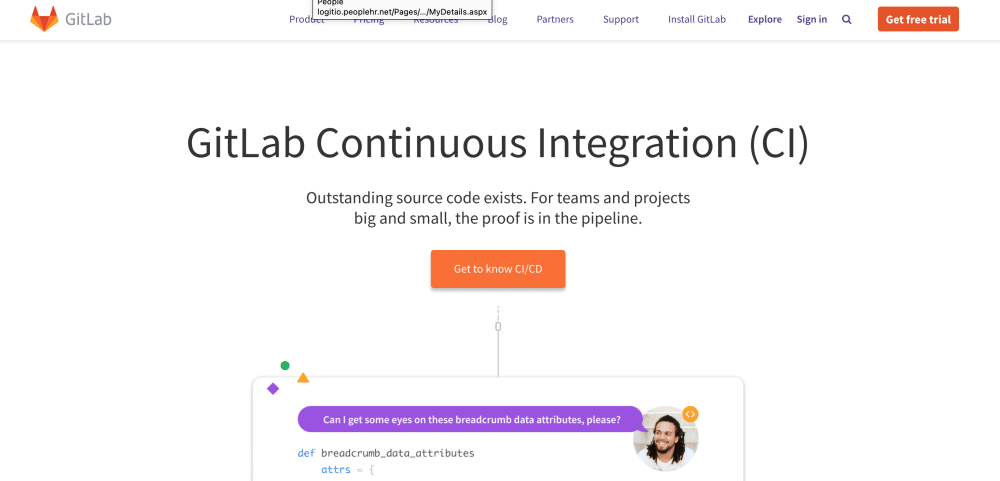
If you are more of a fan of the user interface and tools provided by Gitlab vs Github then Gitlab’s tool for continuous deployment may become your next favourite tool. Gitlab CI was suggested for inclusion in this list by the chief operating officer of Streams Live, Mike Dragan; “GitLab CI is my favorite software deployment tool out there.”
“GitLab CI is a continuous integration tool that is integrated into GitLab, a Git repo hosting and tools platform. It started out as a separate project, but it gained so much momentum that it was integrated into the center in 2015. That means GitLab CI is only compatible with GitLab.”
“GitLab CI has the same 'beautiful' user interface as GitLab. It's free for the community edition, open-source, and easy to learn thanks to the fast start guide. Scalability and delivery are also heavily emphasized.”
“You can easily spread your installations across multiple machines, and there are other interesting features including the ability to run parallel builds on multiple machines. You can also expand the scope of your automated tests by adding more machines.”
If you want to brush up on your knowledge of continuous deployment, continuous delivery and continuous integration then why not check out our previous article all about CI/CD.
3.Jenkins
 Our next popular recommendation is Jenkins which was first recommended by Lacy Summers, CMO at Crush the PM Exam as her choice for the best software deployment tool that has assisted her workflow; “Jenkins is my favorite software deployment tool and is one of the most popular continuous integration and delivery solutions on the market.”
Our next popular recommendation is Jenkins which was first recommended by Lacy Summers, CMO at Crush the PM Exam as her choice for the best software deployment tool that has assisted her workflow; “Jenkins is my favorite software deployment tool and is one of the most popular continuous integration and delivery solutions on the market.”
“Jenkins is written in the Java programming language and is used to continually design and test software projects, making it easier for development teams to integrate changes. It also makes creating a new build easier for its users.”
“Jenkins enables businesses to automate their software development processes. It includes hundreds of plugins, as well as continuous integration and delivery, as well as easy setup and configuration.”
“The tool also incorporates all types of software development life cycle processes, such as constructing, recording, evaluating, deploying, and static analysis, among others. Installer packages are available for Windows, Mac OS X, and other Unix-like operating systems.”
Jenkins was also subsequently recommended by James Little, Director at Simplex Software; “Jenkins is an open-source and widely used software deployment tool that is free to use. It has the flexibility to work with any platform and is not tied to specific languages like some other tools.”
“It does require more time to set up initially, however, this is an extremely popular tool that has flexibility for creating pipelines and deploying software automatically.”
“The tool is the leading open source project for software deployment and we use it almost every day for rapidly pushing out new software. It also has compatibility to work with the vast majority of other integration tools on the market.”
“With support from organisations like AWS, Red Hat and Github, this open-source project has enough of a financial backing behind it to keep up with commercially funded tools.”
4. Envoyer
 “We love using Laravel's Envoyer for software deployment. Although it was started by the same person as Laravel (Taylor Otwell), it should work with pretty much any PHP application.” said Haris Bacic, Co-founder at PriceListo.
“We love using Laravel's Envoyer for software deployment. Although it was started by the same person as Laravel (Taylor Otwell), it should work with pretty much any PHP application.” said Haris Bacic, Co-founder at PriceListo.
Haris went on to explain what is Laravel Envoyer and why his organisation enjoys using this tool; “The beauty of Envoyer is that it is a zero downtime deployment solution. So even while your files are being deployed from a repository, there is absolutely no downtime even while copying or overwriting the files.”
Our next expert contributor Jennifer Willy, Editor at Etia.com contributed the next three tools that assist the Etia team most during their development process.
5. TeamCity
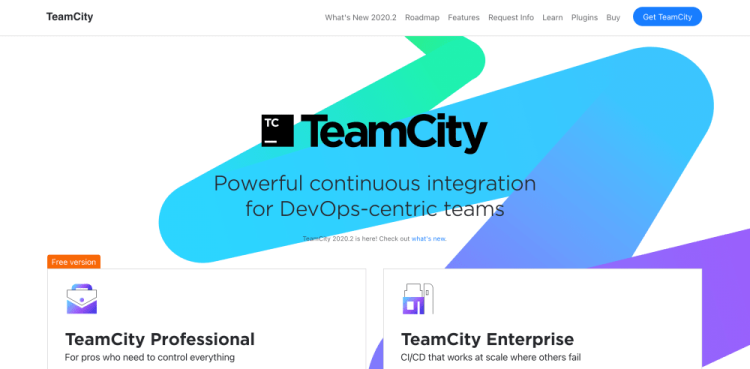 “Our first recommendation would be TeamCity which is a general-purpose CI/CD solution that allows the most flexibility for all sorts of workflows and development practices.”
“Our first recommendation would be TeamCity which is a general-purpose CI/CD solution that allows the most flexibility for all sorts of workflows and development practices.”
“Setting up your first pipeline takes less than 2 minutes and can be done through a simple UI without writing any code”, Jennifer stated in her response.
At Logit.io we also use TeamCity to assist us in managing builds and workflows during our development processes.
6. Octopus Deploy
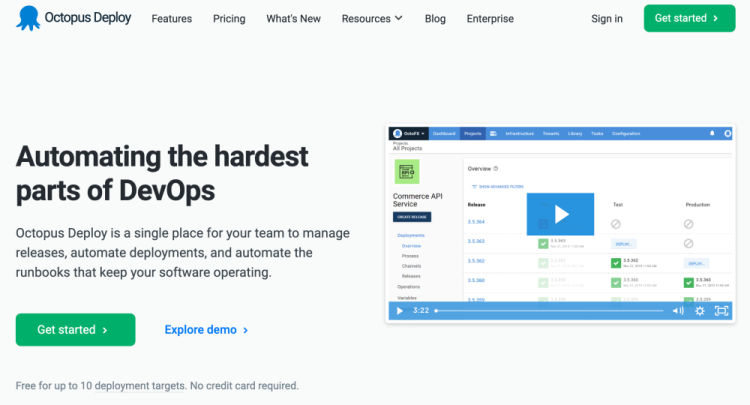 “Octopus Deploy is a single place for your team to manage releases, automate deployments, and automate the runbooks that keep your software operating.”
“Octopus Deploy is a single place for your team to manage releases, automate deployments, and automate the runbooks that keep your software operating.”
“It is the first platform to enable your developers, release managers, and operations folks to bring all automation into a single place.”
Octopus Deploy was also recommended as Kelsey Chan’s first choice for continuous integration for development projects at CocoSign.
“We use Octopus Deploy as the choice of software deployment tool for our business”
Eden Cheng, cofounder of WeInvoice similarly found Octopus Deploy an essential tool; “I have also found Octopus Deploy to be a very useful tool because it eliminates the need for manual deployments in software development by allowing for the automation of emergency and routine tasks across the system.”
“It offers a seamless and easy-to-use dashboard, not to mention it provides easy rollbacks in the event of an error, as well as allows us to track what software versions our clients are using.”
Some of the primary use cases for Octopus Deploy include:
- Eliminating manual deployment from the whole process of software development.
- Providing easy rollbacks in case something goes wrong with the deployment.
- Providing information on which version of the software our clients are using.
7. Bamboo
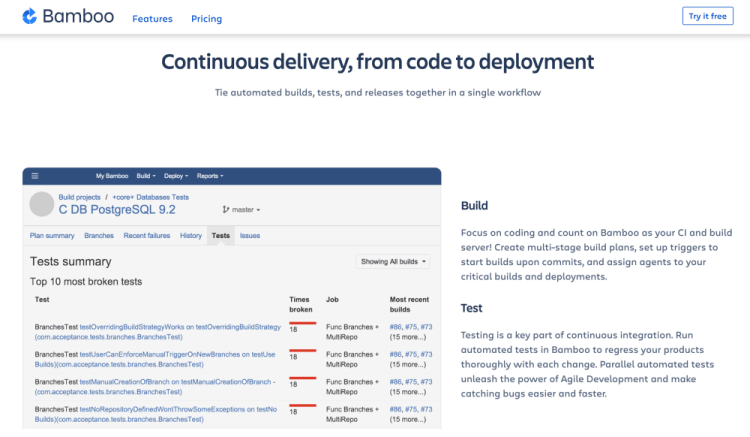 “Bamboo Server is the choice of professional teams for continuous integration, deployment, and delivery”, Jennifer continued for her last recommendation.
“Bamboo Server is the choice of professional teams for continuous integration, deployment, and delivery”, Jennifer continued for her last recommendation.
“Run automated tests in Bamboo to regress your products thoroughly with each change and parallel automated tests to unleash the power of Agile Development and make catching bugs easier and faster.”
Bamboo was also recommended highly by David Morneau, CEO of inBeat Agency; “In my experience, I have personally admired Atlassian’s Bamboo as my personal favorite software deployment tool.”
“It is a continuous integration server that automates release management for applications and general software, enabling teams to establish a streamlined pipeline of build delivery.”
“It binds automated builds, testing, and releases into an integrated workflow. Mobile developers can also deploy their apps back to the Apple Store or Google Play automatically.”
Lastly, Willie Greer, founder of Product Analyst reiterated a number of core features of Bamboo that helps his team to deploy code; “We've been using Atlassian Bamboo for a long period now, and apart from its ability to integrate with other software development platforms, the system can manage the building, testing, and rollout of software, which makes it suitable enough for in-house businesses that develop their own utilities.”
“Software houses that aspire to distribute updates to its existing clients will surely benefit from this software developmental tool. A company can also utilize its existing resources.”
“Apart from that, it can also be used to procure and create download installer packages for new software sales.”
“With this, you can easily be notified of any error reports, as the Bamboo system can also monitor each installation process, and provide alerts at the same time.”
Bamboo offers various numerous features including:
- Language agnostic integration with leading platforms
- Dedicated agents focus on specific build projects
- Full reporting of upcoming code changes and issues
8. Sqitch
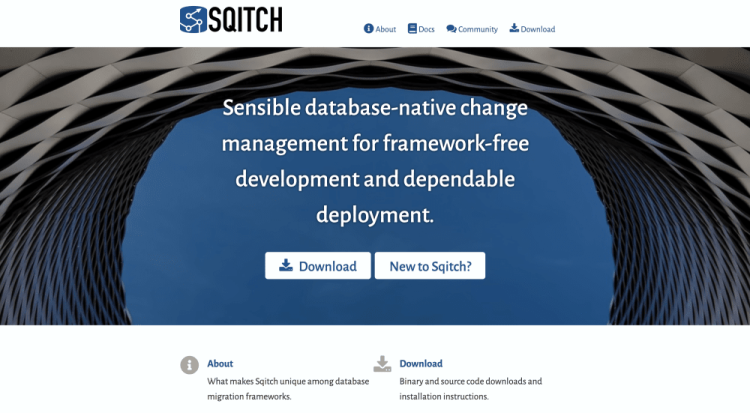 Mark Varnas, Principal Consultant & Founder with Red9 recommended Sqitch as his number one tool for database deployments after finding a number of other deployment tools just weren’t suitable for handling SQL updates.
Mark Varnas, Principal Consultant & Founder with Red9 recommended Sqitch as his number one tool for database deployments after finding a number of other deployment tools just weren’t suitable for handling SQL updates.
“I've seen many deployment tools come and go but most of them were always focused on the code side of things.”
“If we were going to use them for database deployments it was usually us trying to fit a round peg in a square hole.”
“The exception for us is Sqitch. Sqitch is a database change management application. It's like GitHub but is focused on SQL changes.”
“It's not tied to any one SQL implementation so if a client wants to use MySQL, we can use Sqitch. If they want to use Postgres, we're still just as able to use Sqitch for database deployments.”
“The great thing is that Sqitch has version control. We can set dependencies on different Sqitch scripts to ensure that preceding changes are made before subsequent ones so we don't have catastrophic failures due to simple oversights.”
9. AWS CodeDeploy
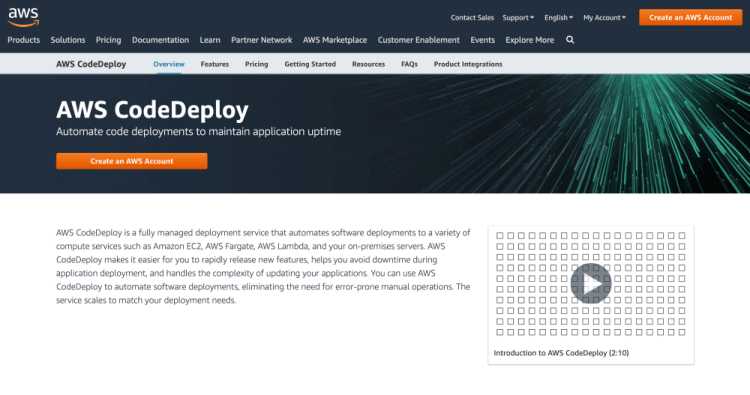 For our last tool Stewart Dunlop, CEO at PPCGenius.io wanted to explain how AWS CodeDeploy has assisted operations at his organisation.
For our last tool Stewart Dunlop, CEO at PPCGenius.io wanted to explain how AWS CodeDeploy has assisted operations at his organisation.
“Software deployment tools allow for developers to conclude their projects, track progress, and manage changes (as well as rollbacks). Continuous integration and continuous deployment may be utilized to deploy software as changes are made, providing seamless updates for end-users.”
“I would strongly recommend AWS CodeDeploy for software deployment as it is the best software deployment tool for small to large businesses in my personal experience.”
“One of the best attributes about AWS is that the platform doesn’t charge any cost for code deployments through CodeDeploy on Amazon EC2 or AWS Lambda.”
“AWS CodeDeploy helps me with the application deployments to Amazon EC2 instances, on-premises instances, serverless Lambda functions, or Amazon ECS services. It also offers the features of Automated Instances Deployments, Minimized Downtime, Centralized Control, Ease of Adoption.
10. Deploybot
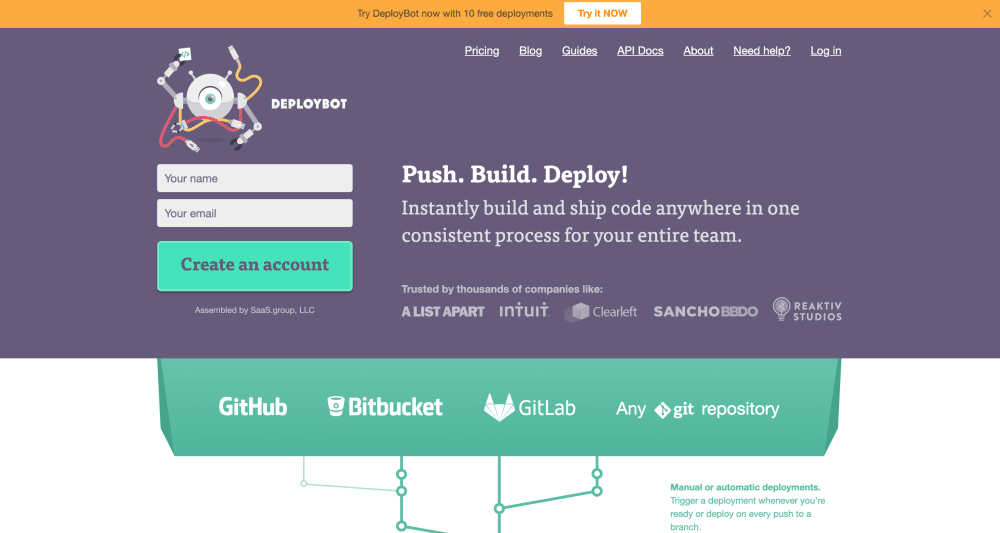 A slightly less well known solution for software deployment that has had a recent surge in popularity is Deploybot, which was suggested by CTO at Smart Billions, Jason Mitchell; “Deploybot is my favorite software deployment tool, in part due to its nature as a highly reliable tool for deploying code from GIT repositories to almost any location.”
A slightly less well known solution for software deployment that has had a recent surge in popularity is Deploybot, which was suggested by CTO at Smart Billions, Jason Mitchell; “Deploybot is my favorite software deployment tool, in part due to its nature as a highly reliable tool for deploying code from GIT repositories to almost any location.”
“Code can be executed on servers using pre-defined or fully custom Docker containers, which can be deployed manually or automatically.”
“Developers can run a variety of shell scripts on the server before and during deployment. Deploybot will also assist you in determining the effect of different deployment stages on app efficiency and stability.”
If you enjoyed this article on the best software deployment tools then why not check out our previous article on What is BABOK? or our post comparing Hadoop vs Spark.
